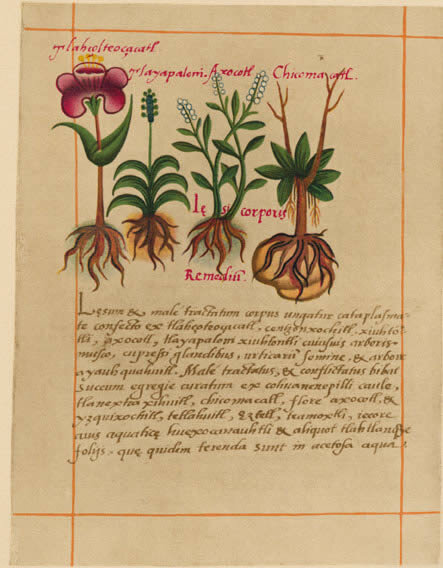Aztechnologically Advanced

In the fifteenth and sixteenth centuries, Aztec medicine was, in some respects, more advanced than European.
In the fifteenth and sixteenth centuries, Aztec medicine was, in some respects, more advanced than European.
Depending upon one’s point of view, we know either very little, or a tremendous amount, about the knowledge of the Aztecs and other Mexican cultures. If that sounds confusing, it’s because the evidence that survived the conquest and colonization of those lands suggests that Aztec physicians had extremely advanced medical theory and pharmacology. We have a couple of surviving textbooks which are full of information, but those books suggest at a wealth of knowledge that didn’t survive.
Since this and other surviving books were generally either written for or translated for European audiences, it can be difficult to know whether the authors and translators adapted some of the ideas. For example, although the Libellus doesn’t contain reference to the humoral theory which was dominant in European medicine, it does explain that Aztec healers shared another European belief, that different parts of the body were meant to be either “hot” or “cold,” that disease appeared when heat and cold were out of balance, and that plants which were inherently hot or cold could therefore be used to treat illness. “Hot” plants often removed water from the body, while “cold” plants might cause sleep.
It’s worth taking a few moments to appreciate the sophistication of the Aztecs. Aztec cities had a reliable aqueduct system. This hardly makes them unique, given that indoor plumbing has existed in one form or another since the days of the Roman Empire, but considering the state of water sanitation in most of the world throughout history, it’s still impressive. Clean water was so readily available that average townspeople bathed daily, which would be inconceivable in Londo or Paris or the day. Streets were cleaned and washed daily, and city cleanliness was overseen by the Aztec equivalent of health inspectors. While there was no water-based system for removing human waste, there was an organized network by which collectors would travel the city and collect refuse which could then be shipped to outlying farms for use as fertilizer. The conquistadors record that Montezuma kept a breathtaking garden, major portions of which were set aside for medicinal plants which were made available to the public. This garden contains hundreds, perhaps thousands of different plants with purported medical uses. Aztec cities had organized hospitals staffed by government-appointed healers, and some form of quality control existed to ensure that healers were competent. None of this ignores the fact that, just as in Europe, a large part of Aztec healing involved prayers, sacrifices, and magical amulets, but unlike in Europe, such remedies at least didn’t make it into the surviving textbooks.
The main Aztec text we have available today is the Libellus de Medicinalibus Indorum Herbis, or Little Book of the Medicinal Herbs of the Indians. This book was written by Martin de la Cruz, an Aztec-born apothecary, and translated by Juan Badiano, a nobleman who was learned in Latin (it’s often known as the Badianus Manuscript as a result). The book was shipped to Spain as a gift for the king and, like most gifts, was promptly put on a shelf and forgotten about. The book passed through various libraries and, although it was mostly ignored by European thinkers who quite cheerfully dismissed anything written by “savages” without so much as reading it, a few copies were made and circulated. The book was none the less more or less forgotten until the early twentieth century, when it was among a pile of other texts bequeathed to the Vatican and rediscovered. Since that time, it’s been the subject of a modest degree of academic study. Perhaps most shockingly, many of the remedies in the book actually seem to work, which distinguishes it from many similar texts of European origin. The vast majority of the remedies described in these books haven’t been tested in modern settings, and many of those which have been tested seem to be ineffective, but the success rate is pretty good compared to other cultures.
Interestingly, since the Aztecs were a people for whom warfare was a central cultural element, their medicine had a strong leaning towards battle and its aftermath. Many drugs existed to give warriors heroic strength, and they appear to have had excellent surgical techniques for cleaning and closing wounds. When we examine some of their recipes for the poultices meant to be applied to wounds, a number of them appear to have some antibiotic effect, which might not be a match for penicillin but certainly outperforms the British practice of pouring boiling oil on a wound.
For all their surgical sophistication, mental illness seems to be a notable gap in the knowledge that has come down to us. We don’t know if Aztec healers didn’t have an organized approach to mental disorder, or, as several historians have instead suggested, mental disorders were removed from those books which went to Europe because Aztec explanations for them were too incompatible with European beliefs. Unfortunately, we’ll likely never know the answer to this question.
More than four years ago, Dr. Eris Lis, M.D., began writing a series of brilliant and informative posts on RPGs through the eyes of a medical professional, and this is the one that appeared here on May 23, 2016. Lis is a physician, gamer, and author of the Skirmisher Publishing LLC OGL sourcebook Insults & Injuries, which is also available for the Pathfinder RPG system.






